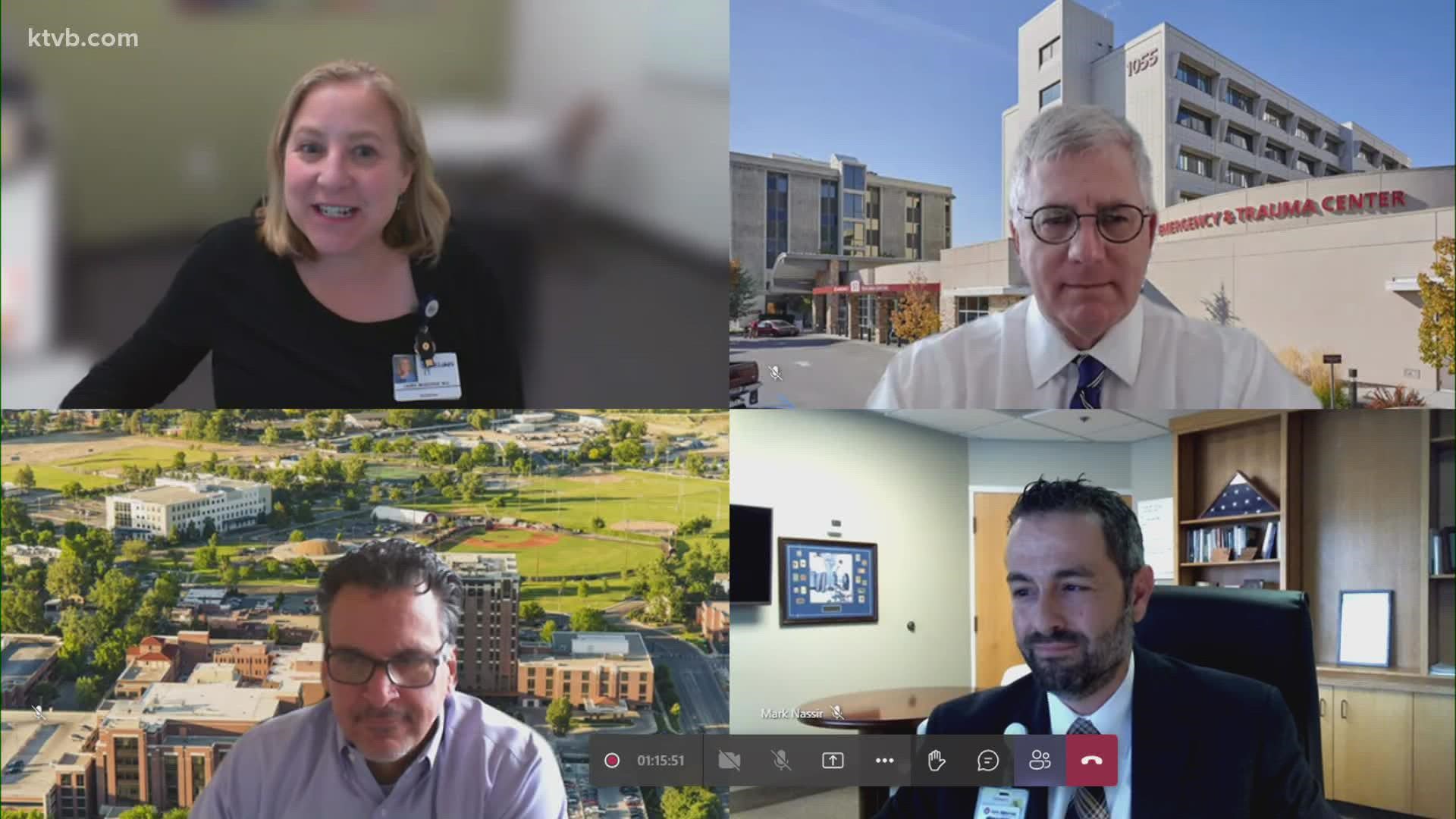BOISE, Idaho — Increased demand for COVID-19 testing, rising positivity rates and the spread of the omicron variant in recent weeks are having an impact on Idaho's hospitals and medical clinics.
In a media briefing Thursday afternoon, medical officers with two of Idaho's largest health systems -- Saint Alphonsus and St. Luke's -- said a "fifth wave" of COVID is beginning, and the number of hospital employees becoming infected with the virus could mean health-care capacity may be as strained, or perhaps more strained, than what Idaho experienced in September, when crisis standards of care were activated.
1,765 total new cases were reported Thursday in Idaho; 1,331 of those cases have been confirmed by PCR testing, and the other 434 are counted as "probable," due to symptoms and likely exposure, but no confirmed test result. Over the past two weeks, the 14-day moving average of new daily cases has increased from about 300 on Dec. 24, 2021, to 714.57 on Thursday, Jan. 6.
As of Thursday, less than a month after the first omicron variant case was confirmed in Idaho, the number of omicron cases has increased to 201.
"The train's coming back. This is very much like the beginning of the pandemic again. And this time it's gonna flatten us, quite honestly. We need to be prepared for that," said Dr. Steven Nemerson, chief clinical officer for Saint Alphonsus Health System. "The same measures we've been talking about for a long time are going to protect us, but we recognize that some people are not going to be able to protect themselves because they're immunocompromised, or the vaccine doesn't work well in particular individuals, and also others will choose not to be protected, so we're here to serve."
Hospitalizations have not increased as dramatically as the numbers of new cases, so far, but they've still increased. On Dec. 24, a total of 225 people were hospitalized with COVID-19 in the 44 facilities that reported numbers to the state. On Jan. 3, a total of 274 hospitalizations were reported by 43 facilities.
Saint Alphonsus reported a total of 20 COVID-19 hospitalizations two weeks ago at all of its hospital locations. Thursday, there were 43. At the height of the delta outbreak in late summer/early autumn of 2021, which Nemerson referred to as "surge number four," Saint Als had about 170 patients hospitalized with COVID.
Nemerson said 125 Saint Alphonsus employees were on COVID leave Thursday, way up from the 14 who were on leave two weeks earlier.
"That's going to have dramatic implications on our ability to take care of patients," Nemerson said. "The reality of the hospital situation, then, is going to be what I presented in previous surges: longer lines for care, longer time periods to be seen, fewer beds available, expansion of staff to take care of more patients, and in this case, if this trend continues, and we expect it to do so, we will be further impaired from accommodating the same number of patients we were able to take care of during surge number four (August-October 2021)."
Nemerson said the worst-case scenario - rationing care and triage - did not become reality when Idaho hospitals were in crisis standards of care in the fall of 2021, and he hopes it doesn't happen this time.
"But I'm afraid it may this time, because our resources are more constrained, our flexibility is less, and functionally, that means we're going to be able to care for fewer patients," Nemerson said, adding crisis standards may need to be activated sooner than they were during what he called surge number four.
A positive Nemerson mentioned: the rate of new cases leading to hospitalizations or deaths is lower.
"Why is that the case? It's because people are vaccinated and boosted," he said. "We've done the right things to prepare for this as best we can, and we will continue to serve the community."
On testing, St. Luke's medical director for primary care Dr. Laura McGeorge said like many other hospitals, St. Luke's is seeing an "exponential" demand for tests, and that people seeking to be tested for COVID are having a difficult time.
"We have gone from same-day or within-a-day turnaround (for results), and sometimes it can take several days to sign up to get a spot to get tested," McGeorge said. "We're trying to work through that."
Also, McGeorge advised that people not go to the emergency room, urgent care, or even your primary care doctor just to get a COVID test.
"They really are extremely busy right now taking care of patients, and we need to continue to keep those resources doing what they do best," she said. "If you have symptoms and are having difficulty getting a test, use your best judgment, but you should isolate and assume that you have COVID until you're able to get tested."
The statewide testing positivity rate for the week that ended Jan. 1 was 17.1% out of 27,042 PCR tests performed. The week before, the rate was 8.6% out of 25,378 tests. The Idaho Dept. of Health and Welfare said Thursday that increase, basically double, is the biggest weekly increase since the beginning of the pandemic.
Thursday's media briefing was livestreamed on KTVB.COM and the KTVB YouTube channel.
RELATED: Latest Idaho COVID-19 case and vaccine numbers: Interactive graphs and maps tracking the pandemic
Facts not fear: More on coronavirus
See our latest updates in our YouTube playlist:


